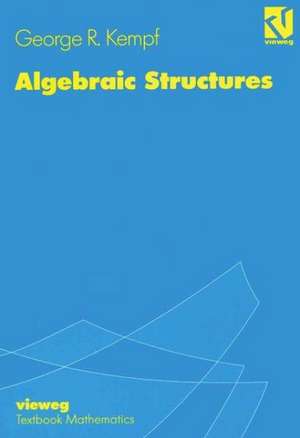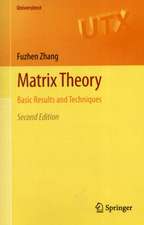Algebraic Structures
Autor George R. Kempfen Limba Engleză Paperback – 1995
Preț: 232.49 lei
Nou
Puncte Express: 349
Preț estimativ în valută:
44.49€ • 46.19$ • 37.10£
44.49€ • 46.19$ • 37.10£
Carte tipărită la comandă
Livrare economică 18-24 martie
Preluare comenzi: 021 569.72.76
Specificații
ISBN-13: 9783528065836
ISBN-10: 3528065834
Pagini: 180
Ilustrații: IX, 166 p.
Dimensiuni: 162 x 229 x 9 mm
Ediția:Softcover reprint of the original 1st ed. 1995
Editura: Vieweg+Teubner Verlag
Colecția Vieweg+Teubner Verlag
Locul publicării:Wiesbaden, Germany
ISBN-10: 3528065834
Pagini: 180
Ilustrații: IX, 166 p.
Dimensiuni: 162 x 229 x 9 mm
Ediția:Softcover reprint of the original 1st ed. 1995
Editura: Vieweg+Teubner Verlag
Colecția Vieweg+Teubner Verlag
Locul publicării:Wiesbaden, Germany
Public țintă
Upper undergraduateCuprins
1 Fundamentals of Groups.- 1.1 Sets and Mappings.- 1.2 Groups.- 1.3 Formal Properties of Groups and Homomorphisms.- 1.4 Group Actions.- 1.5 Subgroups and Cosets.- 1.6 Normal Subgroups and Quotient Groups.- 1.7 Exponents and Orders.- 1.8 Permutations.- 1.9 More on Group Actions.- 1.10 Products.- 1.11 A Simpler Definition of a Group.- 2 Fundamentals of rings and fields.- 2.1 Rings.- 2.2 Ideals and Quotient Rings.- 2.3 Integral Domains and Fields.- 2.4 The Integers as a Ring.- 2.5 Principal Ideal and Euclidean Domains.- 2.6 Polynomials.- 2.7 Examples of Fields.- 2.8 Gauss’ Theorem.- 2.9 More Polynomials.- 3 Modules.- 3.1 The Definitions.- 3.2 Bases and Free Modules.- 3.3 Vector Spaces.- 3.4 Modules over a Euclidean Domain.- 3.5 Hom.- 4 A little more group theory.- 4.1 Sylow’s Theorems.- 4.2 1D45D-Groups.- 4.3 Cyclic Finite Groups.- 4.4 Solvable and Simple Groups.- 5 Fields.- 5.1 The Beginning.- 5.2 Degree of Finite Extensions.- 5.3 The Field of Algebraic Elements.- 5.4 Splitting Fields.- 5.5 Existence of Automorphisms.- 5.6 Galois Extensions.- 5.7 Galois Theory.- 5.8 Separable Extensions.- 5.9 Steinitz’s Theorem.- 6 More field theory.- 6.1 The Frobenius.- 6.2 Finite Fields.- 6.3 Roots of Unity.- 6.4 Constructible Numbers.- 6.5 Constructing Regular 1D45B-Gons.- 6.6 Solvable Extensions.- 6.7 Transcendence Degree.- 6.8 The General Equation.- 6.9 Algebraically Closed Fields.- 6.10 Endomorphisms of Vector Spaces.- 7 Modern linear algebra.- 7.1 Tensor Products.- 7.2 Multiple Tensor Products.- 7.3 Graded Rings.- 7.4 The Tensor Algebra.- 7.5 The Symmetric Algebra.- 7.6 The Exterior Algebra.- 7.7 Determinants and Inverses.- 7.8 Characteristic Polynomia.- 7.9 Differential Forms.- 8 Quadratic and alternating forms.- 8.1 Quadratic Forms.- 8.2 The Real Case.- 8.3 The ComplexCase.- 8.4 Hermitian Forms.- 8.5 Alternating Pairings.- 9 Ring and field extensions.- 9.1 Differentials.- 9.2 Decomposition of Tensor Product of Fields.- 9.3 The Normal Basis Theorem.- 9.4 Trace.- 9.5 Theorem 90.- 9.6 Inseparable Extensions.- 9.7 Artin-Schreier Equation.- 10 Noetherian rings and localization.- 10.1 Noetherian Rings.- 10.2 Spec A.- 10.3 Localization.- 10.4 Exact Sequences.- 10.5 Local Rings.- 10.6 Principal Ideal Domains.- 10.7 Nilpotents.- 10.8 Mac Lane’s Criterion.- 11 Dedekind domains.- 11.1 The Definition.- 11.2 Discrete Valuation Rings.- 11.3 The Class Group.- 11.4 Number Theory.- 11.5 Integral Closure.- 11.6 Gaussian Integers.- 12 Representations of Groups.- 12.1 Introduction.- 12.2 Uniqueness of Irreducible Decomposition.- 12.3 Irreducible Representation of a Finite Group.- 12.4 Representation of Abelian Groups.- 12.5 Complex Representations.- 13 More modules.- 13.1 Artin-Rees Lemma.- 13.2 Associated Primes.- 13.3 Primitive Modules.- 13.4 Primary Ideals.- 13.5 Uniqueness.- 13.6 Graded Modules.- 13.7 Prime Divisor.- 14 Categories.- 14.1 The Definition.- 14.2 Examples of Categories.- 14.3 Examples of Functors.- 14.4 Natural Transformations.- 15 Completion.- 15.1 Inverse Limits.- 15.2 Completion of Rings.- 15.3 Completion of Modules.- 15.4 Exactness of Inverse Limits.- 15.5 Noetherianness.- 16 Lie algebra.- 16.1 Introduction.- 16.2 The Universal Enveloping Algebra.- 16.3 Revision.- 17 The Clifford algebra.- 17.1 The Statement.- 17.2 The Proof.- 18 Commutative rings.- 18.1 Dimension.- 18.2 Cohen-Seidenberg Theory.- 18.3 Dimension.- 18.4 Noether Normalization.- 19 Logic.- 19.1 Zorn’s Lemma.- 19.2 Applications.- 19.3 The Axiom of Choice.- 19.4 The Proof of Zorn’s Lemma.- 19.5 Well-Ordering.- 19.6 Existence of Algebraically Closed Fields.- 20Tor’s.- 20.1 Complexes.- 20.2 Definition of Tor.- 20.3 The Proofs.- 20.4 Koszul Complex.- 20.5 Different Resolutions.- 20.6 Efficient Ways to Compute Tor.- 20.7 Hilbert’s Theorem.
Notă biografică
Prof. Georg Kempf lehrt an der Johns Hopkins University; Baltimore, Maryland, USA.















